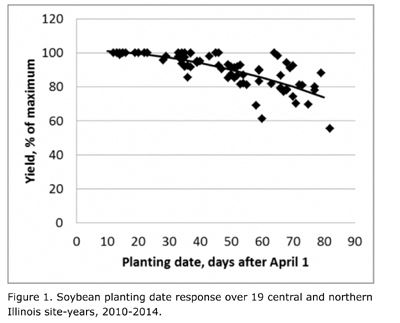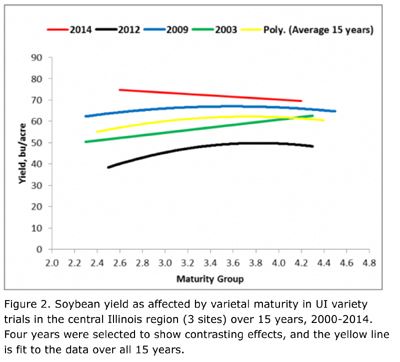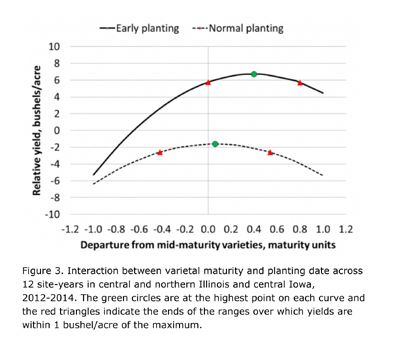Soybean Planting Date And Varietal Maturity
DR. EMERSON NAFZIGER AND JAKE VOSSENKEMPER
URBANA, ILL.
Along with the continuing emphasis on getting soybean planted early – in late April to early May – comes the question of soybean maturity rating, and whether early planting benefits fuller- or shorter-season varieties the most.
Planting date
Figure 1 was updated with the 2014 data from our planting date trials in central and northern Illinois. The change compared to the response I showed a year ago is mostly from the large response to delayed planting at Urbana in 2014. Here, the April 23 planting yielded 95 bushels per acre, and yields dropped as a straight line (rather than the usual accelerating loss), losing a little more than a half bushel per day of delay, to only 66 bushels per acre planted on June 15. That dragged down the line some, with accumulated losses of about 5 and 16% by the end of April and end of May, respectively. There is a lot of spread of data at different dates, so we know that actual losses won’t hit the line on the graph most of the time.
Varietal maturity
Jake Vossenkemper, a PhD student working with me, has been doing research to see how planting date affects yields of soybean varieties that differ in maturity. The first question is whether varietal maturity has a consistent effect on yield by itself. Data from the central Illinois region of the UI variety trials over the past 15 years shows that this effect is not very consistent – yields of later-maturing varieties can be higher or lower than those of early-maturing ones depending on the year (Figure 2). On average, though, mid-maturity varieties tend to yield slightly more than either early or late varieties, and those within a bushel of the top-yielding maturity covered a spread of about one half of a maturity group on either side of the highest-yielding group (Figure 2). It is also clear that yields are much more closely tied to genetic potential than they are to maturity itself, even though on average varieties with very early or very late maturity tend to yield less.
Planting date and varietal maturity: do they interact?
We can see in Figure 2 that the type of growing season can have a considerable effect on how yields are affected by maturity. But how does this work when planting dates are different within a growing season? To address this question we have run a series of trials using a range of varietal maturities over a number of sites in different regions over recent years. Trends in different regions were similar, but we’ll show here the large data set (12 site-years) from central and northern Illinois and one site in Iowa. Varietal maturity ranged from about 1.9 to 3.8 with the baseline at about 2.9 in the northern sites, and from 2.5 to 4.5 with the baseline at about 3.5 in the central sites.
With early (late April to early May) planting, yields across the 12 site-years were maximized at a maturity that was about 0.4 units later than the mid-maturity baseline, and yields were within a bushel of the maximum (of about 74 bushels per acre) over maturities ranging from the baseline to about 0.8 units above the baseline, or about 0.4 units on either side of the maximum (Figure 3). When planting was at the normal time of late-May, the maximum yield dropped to about 66 bushels, or 7 to 8 bushels lower than the maximum with early planting, in line with the expectation based on planting date (Figure 1). At the later planting, varieties with a maturity close to the baseline maturity yielded the most, and the range of maturities that yielded within a bushel of the maximum was slightly wider than with early planting, ranging from about 0.5 units below to 0.5 units above the maximum (Figure 3).
Do we see enough here to try to tailor the maturity we use for planting at different times? Probably not in terms of changing maturity on the fly as planting time approaches – the decision on best-performing varieties has to be made before then, and if made with care should be solid enough to stand regardless of planting date. But if you have fields where early planting is often possible, you might “shade” towards a little longer maturities for those, and if there are fields that often stay wet until past mid-May, choosing from among adapted mid-season varieties makes sense. There seems to some advantage in choosing to plant fuller-season varieties earlier rather than later, though that strategy tends to work against the goal of using different maturities to spread harvest. ∆
DR. EMERSON NAFZIGER: Research Education Center Coordinator, Professor, University of Illinois
JAKE VOSSENKEMPER: Research Assistant, University of Illinois


